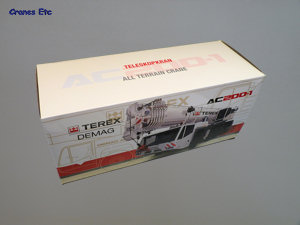 | | Terex Demag box. |  | 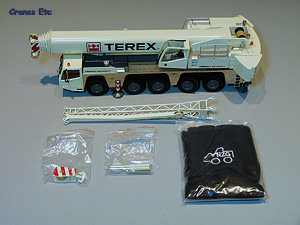 | | The parts out of the box. | 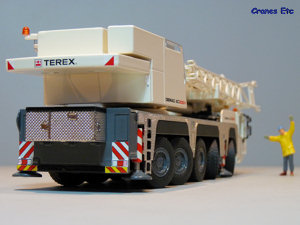 | | Rear view. | 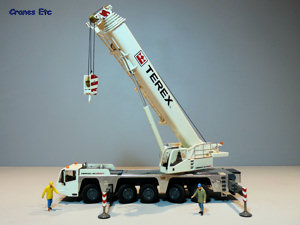 | | Waiting for the counterweight to arrive. | 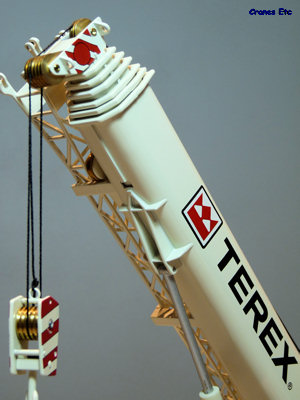 | | Brass pulleys are single pieces rather than separate sheaves. | 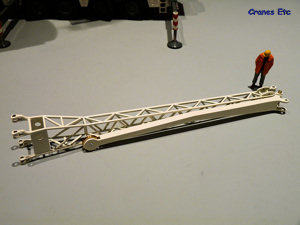 | | The lattice fly jib. | 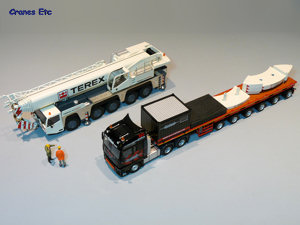 | | It poses well with a Nooteboom ballast carrier. |
| The AC 200-1 is a nominal 200t capacity five axle crane (also available in six axle configuration in some countries) from the Demag stable. For photos of the real machine click here.
The model was first introduced in 2003 as NZG 514. In 2008 this updated version was introduced and this review is an update of the review of the previous model.
Packaging
The packaging for this model consists of a good quality outer sleeve with photos, which contains a two piece polystyrene box containing the model. The polystyrene halves have finger notches to enable easy removal from the sleeve and are marked top and bottom as well as having the model name. Inside, the model is carefully wrapped. No instructions are provided but assembly of the few parts is straightforward. There were no defects or missing parts on the review model.
NZG also provide a pair of cotton-type gloves with the model to prevent finger marks on the model.
Detail
The model looks very good. Starting with the carrier, the wheels are well detailed as is the rest of the carrier body. The driving cab has windscreen wipers, mirrors and orange beacons. The mirrors come already fixed rather than the normal practice of having them provided separately for fixing. Lights are painted on. The cab interior details are simple, and there is a fine loop at the front of the crane for attaching the hook during transport.
Location points are provided on the carrier body for loading the counterweights during erection.
The crane body detail is also good with wipers on the cab and excellent handrail and stepping details. The hook block is very good and in keeping with the size of the crane. The pulleys are brass although this is a one-piece block and as the pulleys in the boom are also one-piece (the pulleys are not individually separate) unwinding the rope is not smooth. The hook can be posed how you like but this is not a model for winding up and down to lift a load. The hook itself rotates from the block and this allows more flexibility in posing lifts.
The main boom is in seven sections. A folding fly jib is provided and has well formed latticework.
The changes on this model compared to the previous version appear to be cosmetic and related to the graphics rather than any changes to the castings. In this sense the updating is not really significant and it would have been good if the counterweight and been broken down into further separate pieces for example.
Features
The front and rear pairs of axles steer. Each pair is linked together and they steer well in tandem so most of the steering modes of the real crane can be replicated.
The outriggers are very good. They each have two stage outrigger beams with a robust screw and excellent painted metal pads.
The crane cab can be tilted.
The boom cylinder has been drilled with a hole so that it can be pinned when erect to prevent boom sag. Thoughtfully the hole is in the plane of the boom so it is not visible for most practical purposes. The boom is a seven section telescope and extends well.
At the boom head the folding fly jib can be attached by pins and this is straightforward to do.
The winch is operated using one of the tools NZG provide for the purpose which works well and avoids spoiling the look with a winding handle.
The main counterweight is attached to the crane body by a pair of screws. When attached the overall effect is good, and the crane can rotate fully without a problem. However if the counterweight is removed and rested on the carrier using the locating lugs then the crane body cannot rotate as it is fouled by the counterweight. This appears to be scaling problem and in reality is of little practical consequence because it does not prevent the crane being posed in almost every possible way. When in transport mode the model still has one counterweight plate permanently attached.
Quality
The paint finish is very high quality as are the decals. Most parts are metal including the outrigger beams. The moving parts all work well. Overall the model gives a very good impression because of its detail, finish and weight. In fact it is very heavy adding to the quality feeling.
Price
After being in production for a number of years the model is now very good value for a five axle crane.
Overall
This model is very good overall and looks good in a variety of poses. Although this is an updated version the changes are not significant and although it is relatively better value than when first introduced it is a pity the opportunity to improve some of the features was not taken. With that said, collectors will continue to like this model.
Footnotes
The model first appeared at the Nuremberg Toy Fair in 2003 as model number 514. In 2012 a further revised version was released as model 869.
|
| |
| 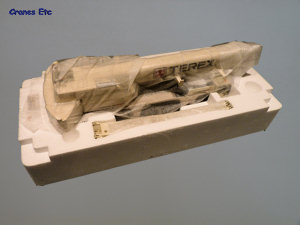 | | The model inside the box. | 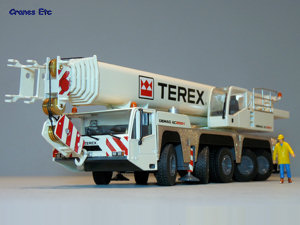 | | On the road. | 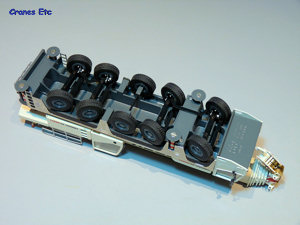 | | Underside. | 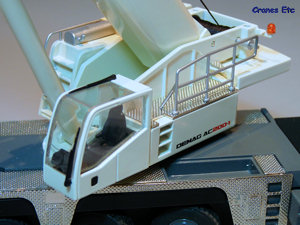 | | Handrails are good. | 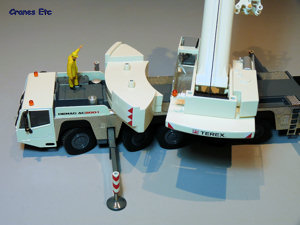 | | Counterweight ready for attachment. | 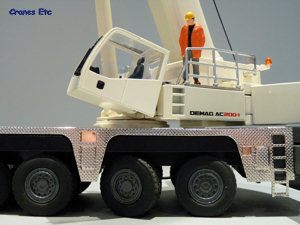 | | Tilting cab. | 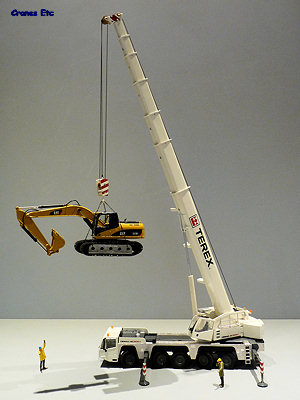 | | Lifting a CAT 323D L. |
|

